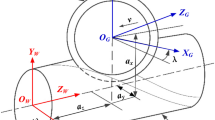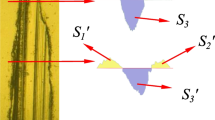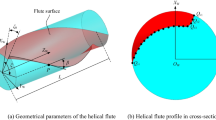Abstract
Solid cutting tool is more and more widely used, such as aerospace, automobile and 3C. Helical groove is an important feature which influences the performance of solid cutting tool. Furthermore, groove grinding is the longest and largest material removal process in whole grinding of solid tool. Therefore, the most wear of grinding wheel occurs in its grinding. The worn wheel would result in groove grinding error without a proper compensation. The traditional compensation relies on the experience of machine operator, and generally, it is performed on site. In this paper, a compensation algorithm of worn wheel is proposed by analysing the boundary contact condition which is influenced by wheel wear. Furthermore, the algorithm is implemented by using C# and validated by a set of and experiments. The experimental results show that the ground tool flutes under compensation algorithm are controlled within designed tolerances; i.e., core radius errors are 1.7% and 0.7%, rake angle errors are 1.5% and 0.6%, and edge width errors are 4.3% and 5%.















Similar content being viewed by others
References
Kara F, Çiçek A, Demir H (2013) Multiple regression and ANN models for surface quality of cryogenically-treated AISI 52100 bearing steel. J Balkan Tribol Assoc 19:570–584
Ji R, Zheng Q, Liu Y, To S, Yip WS, Yang Z, Jin H, Wang H, Cai B, Cheng W (2019) An investigation of mechanical-thermal coupling treatment on material properties, surface roughness, and cutting force of Inconel 718. Int J Adv Manuf Technol 105(5–6):1917–1931. https://doi.org/10.1007/s00170-019-04340-7
Yin S, Ji W, He G, Liu X, Wang L (2018) Experimental evaluation on texture of flank face on tool wear in chamfer milling of stainless steel. Int J Adv Manuf Technol 99(9–12):2929–2937. https://doi.org/10.1007/s00170-018-2657-7
Ji W, Liu X, Wang L, Meng Y, Wu X (2015) A study on geometry modelling of a ball-end mill with chamfered cutting edge. J Manuf Process 19:205–211
Ji W, Liu X, Wang L, Wang G (2016) Research on modelling of ball-nosed end mill with chamfered cutting edge for 5-axis grinding. Int J Adv Manuf Technol 87(9–12):2731–2744. https://doi.org/10.1007/s00170-016-8631-3
Li G, Sun J, Li J (2014) Modeling and analysis of helical groove grinding in end mill machining. J Mater Process Technol 214(12):3067–3076. https://doi.org/10.1016/j.jmatprotec.2014.07.009
Kang SK, Ehmann KF, Lin C (1996) A CAD approach to helical groove machining—I. mathematical model and model solution. Mech Eng 36(\):141-153
Kim JH, Park JW, Ko TJ (2008) End mill design and machining via cutting simulation. Comput Aided Des 40(3):324–333. https://doi.org/10.1016/j.cad.2007.11.005
Wu CT, Chen COK (2001) Manufacturing models for the design and NC grinding of a revolving tool with a circular arc generatrix. J Mater Process Technol 116(2):114–123
Li G (2017) A new algorithm to solve the grinding wheel profile for end mill groove machining. Int J Adv Manuf Technol 90(1–4):1–10
Kang SK, Ehmann KF, Lin C (1997) A CAD approach to helical groove machining. Part 2: numerical evaluation and sensitivity analysis. Int J Mach Tools Manuf 37(1):101–117
Karpuschewski B, Jandecka K, Mourek D (2011) Automatic search for wheel position in flute grinding of cutting tools. CIRP Ann 60(1):347–350. https://doi.org/10.1016/j.cirp.2011.03.113
Li G, Zhou H, Jing X, Tian G, Li L (2017) An intelligent wheel position searching algorithm for cutting tool grooves with diverse machining precision requirements. Int J Mach Tools Manuf 122:149–160. https://doi.org/10.1016/j.ijmachtools.2017.07.003
Xiao S, Wang L, Chen ZC, Wang S, Tan A (2013) A new and accurate mathematical model for computer numerically controlled programming of 4Y1 wheels in 2½-axis flute grinding of cylindrical end-mills. J Manuf Sci Eng 135(4). https://doi.org/10.1115/1.4023379
Habibi M, Chen ZC (2017) A generic and efficient approach to determining locations and orientations of complex standard and worn wheels for cutter flute grinding using characteristics of virtual grinding curves. J Manuf Sci Eng 139(4). https://doi.org/10.1115/1.4035421
Ren L, Wang S, Yi L (2018) A generalized and efficient approach for accurate five-axis flute grinding of cylindrical end-mills. J Manuf Sci Eng 140(1). https://doi.org/10.1115/1.4037420
Ren L, Wang S, Yi L, Sun S (2016) An accurate method for five-axis flute grinding in cylindrical end-mills using standard 1V1/1A1 grinding wheels. Precis Eng 43:387–394. https://doi.org/10.1016/j.precisioneng.2015.09.002
Wang L, Chen ZC, Li J, Sun J (2015) A novel approach to determination of wheel position and orientation for five-axis CNC flute grinding of end mills. Int J Adv Manuf Technol 84(9–12):2499–2514. https://doi.org/10.1007/s00170-015-7851-2
Chen Z, Ji W, He G, Liu X, Wang L, Rong Y (2018) Iteration based calculation of position and orientation of grinding wheel for solid cutting tool flute grinding. J Manuf Process 36:209–215
Liu X, Chen Z, Ji W, Wang L (2019) Iteration-based error compensation for a worn grinding wheel in solid cutting tool flute grinding. Procedia Manuf 34:161–167. https://doi.org/10.1016/j.promfg.2019.06.134
Funding
This work was supported by the Natural Science Foundation of China (Grant No. 51720105009), University Nursing Program for Young Scholars with Creative Talents in Heilongjiang Province (Grant No. UNPYSCT-2018201), and the Natural Science Foundation of Heilongjiang Province, China (Grant No. QC2016070).
Author information
Authors and Affiliations
Corresponding author
Additional information
Publisher’s note
Springer Nature remains neutral with regard to jurisdictional claims in published maps and institutional affiliations.
Rights and permissions
About this article
Cite this article
Liu, X., Chen, Z., Ji, W. et al. A compensation method for wheel wear in solid cutting tool groove grinding based on iteration algorithm. Int J Adv Manuf Technol 107, 3389–3399 (2020). https://doi.org/10.1007/s00170-020-05269-y
Received:
Accepted:
Published:
Issue Date:
DOI: https://doi.org/10.1007/s00170-020-05269-y




